|
|
|
Sort Order |
|
|
|
Items / Page
|
|
|
|
|
|
|
| Srl | Item |
| 1 |
ID:
183562
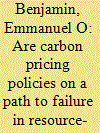

|
|
|
|
|
| Summary/Abstract |
There are limited studies on specific factors that affect willingness-to-pay (WTP) and public concerns on spending of pollution pricing in democratic economies that are carbon dependent. In light of the discourse on global pollution pricing, this study explores the complex influence of political-economic, attitudinal, and socio-demographic factors on carbon pricing, by estimating the WTP in a carbon resource-dependent economy such as Canada and the preferred revenue earmarking of Canadians. An online survey of 600 Canadian households was conducted using the random device engagement (RDE) approach. This study uses a contingent valuation method (CVM) and payment card (P.C.) to estimate the household WTP for carbon pricing on direct energy expenditure and an ordered logistic regression model for odds ratio estimates. The estimated annual WTP ranges between CAD$ 84 to CAD$ 230 in 2019 (CAD$ 1 = US$ 0.7538). This implies an acceptable increment of 1.5%–2.5% (CAD$ 157 to CAD$ 259) to the average yearly household energy expenditures. This study suggests that Canadians appear to be supportive of redistributing carbon price revenues and investing in clean energy technology. Canadian government needs to address public concerns surrounding political-economic factors, specifically the energy cost implication for vulnerable households in order to achieve emission reduction targets.
|
|
|
|
|
|
|
|
|
|
|
|
|
|
|
|
| 2 |
ID:
179734
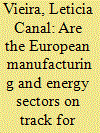

|
|
|
|
|
| Summary/Abstract |
The European Green Deal has established a 2050 net-zero emissions target to tackle climate change. The manufacturing and energy sectors account for at least 40% of European emissions and are central in the transition to a low-carbon economy. Thus, devising suitable strategies for reaching net-zero emissions requires a comprehensive analysis of emissions reductions achieved by the two sectors. This paper has a two-fold aim: firstly, to empirically analyse European energy and manufacturing facilities’ abatement results; secondly, to expose whether the two sectors are on track to achieve net-zero emissions by 2050. We used European Union Emissions Trading System data from 2005 to 2017 from France, Germany, Italy, Spain, and the United Kingdom to analyse the homogeneity of mitigation performances and the distribution of emissions among installations. The results indicate that a large share of installations have not decreased emissions yet, although there is substantial variety in units' contribution to total carbon releases. A smaller bundle of units (from 13 to 23%) containing super-polluters is responsible for up to 95% of emissions. The findings highlight that achieving net-zero emissions by 2050 will require additional policies that are tailored to super-polluters and also support installations that have not started their decarbonisation pathway.
|
|
|
|
|
|
|
|
|
|
|
|
|
|
|
|
| 3 |
ID:
166989
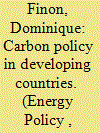

|
|
|
|
|
| Summary/Abstract |
Carbon pricing might not be appropriate as the main element of the carbon policy package in emerging and developing countries (DCs), because the political economy constraints are greater than in developed countries. Non-price instruments and policies such as efficiency standards, market-oriented regulation, subsidies for clean technologies and public programs involving low carbon infrastructure should be preferentially developed to deal with market and regulatory failures, which are more widespread than in developed countries. These approaches are most effective in orientating technology and infrastructure, the principal means to achieving the mitigation imperative in DCs. Moreover, even if, in theory, policy packages using non-price instruments are less socially efficient than those focused on carbon pricing, they allow governments to circumvent political economy constraints, because their costs to consumers and citizens are not generalized and tend to be much less visible, while their redistributive effects are, if appropriately designed, generally not too regressive. In the end, developing a carbon policy that emphasizes non-price instruments and measures will pave the way to leverage carbon pricing as the main pillar of their future carbon policy in long term.
|
|
|
|
|
|
|
|
|
|
|
|
|
|
|
|
| 4 |
ID:
166939


|
|
|
|
|
| Summary/Abstract |
Governments in Ontario and Quebec, two Canadian provinces, have required their fuel distributors to participate in carbon markets and to buy allowances covering their greenhouse gas emissions. The resulting carbon pricing can impose an indirect tax on gasoline retailers through the higher wholesale price they pay. This paper's goal is to measure carbon pricing pass-throughs in Ontario and Quebec's wholesale gasoline markets. Although carbon pricing pass-throughs are uniform within each province, they are higher in Ontario where over-shifting is observed. Higher (lower) levels of pass-throughs in Ontario (Quebec) might be explained by less (more) competitive wholesale gasoline markets.
|
|
|
|
|
|
|
|
|
|
|
|
|
|
|
|
| 5 |
ID:
192340


|
|
|
|
|
| Summary/Abstract |
Trade liberalization in the Regional Comprehensive Economic Partnership (RCEP) not only contributes to regional economic growth but also leads to an increase in energy consumption and carbon emissions, which may exacerbate climate change risks. This study aims to explore the carbon pricing issue in the context of the RCEP framework. Additionally, for the sake of carbon equity, we introduce a differentiated carbon pricing scheme based on the cost fairness principle (CPCF), and the unified carbon pricing was used for a cost effectiveness analysis. The empirical analysis was conducted with a global multi-regional computable general equilibrium model. The results show that with the help of trade liberalization, the RCEP's GDP, energy consumption, and carbon emissions may increase by 0.639%, 1.962%, and 1.897%, respectively. The CPCF scheme, wherein developed countries assume the primary abatement burden, can be used to offset the increase in carbon emissions from trade liberalization while RCEP members maintain positive economic growth. The total abatement cost of the CPCF for carbon offsets in the RCEP can be reduced via unified carbon pricing, and the cost-saving effect approaches 24.24%. Unified carbon pricing may result in a carbon price of US $5.83 within the RCEP. As such, this study explores carbon pricing in the context of trade liberalization, and its findings will be valuable for the RCEP to achieve a win-win situation in terms of economic growth and climate change.
|
|
|
|
|
|
|
|
|
|
|
|
|
|
|
|
| 6 |
ID:
186443


|
|
|
|
|
| Summary/Abstract |
Carbon prices and carbon caps need to be set at levels that will deliver the reduction targets necessary to keep global warming under 2 °C, aspiring to 1.5 °C above pre-industrial levels, in line with the Paris Agreement. Given both the urgency of the situation and the heterogeneity across countries and sectors, switching caps and switching prices may be the answer.
|
|
|
|
|
|
|
|
|
|
|
|
|
|
|
|
| 7 |
ID:
171520
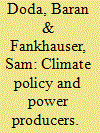

|
|
|
|
|
| Summary/Abstract |
Climate policies do not affect all power producers equally. In this paper, we evaluate the supply-side distributional consequences of emissions reduction policies using a simple and novel partial equilibrium model where production takes place in technology-specific sites. In a quantitative application hydro, wind and solar firms generate power combining capital and sites which differ in productivity. In contrast, the productivity levels of coal, gas and nuclear technologies are constant across sites. We parameterise the model to analyse the effects of stylised tax and subsidy schemes. Carbon pricing outperforms all other instruments and, crucially, leads to more equitable outcomes on the supply side. Technology-specific and uniform subsidies to carbon-free producers result in a greater welfare cost and their supply-side distributional impacts depend on how they are financed. Power consumption taxes have exceptionally high welfare costs and should not be the instrument of choice to reduce emissions or to finance subsidies aiming to reduce emissions.
|
|
|
|
|
|
|
|
|
|
|
|
|
|
|
|
| 8 |
ID:
183582


|
|
|
|
|
| Summary/Abstract |
With firm-level panel data for seven years, this study evaluated the effect of carbon pricing policy and analyzed how firms respond to the carbon price, focusing on Korea's Emission Trading Scheme (ETS). Under the assumption that firms' responses to the carbon price might differ across industries, this study compared the manufacturing and electricity generation sectors. Our panel regression analyses show that the ETS has significant impacts on firms' carbon reduction. However, the carbon reduction mechanisms of firms differ by industrial sector. Firms in the manufacturing sector reduced carbon emissions by improving the energy efficiency of their facilities. On the other hand, those in the electricity generation sector reduced emissions by phasing out the use of fossil fuels and by giving more weight to low carbon-intensive energy sources. These findings imply that carbon pricing works as designed, sending economic signals for firms to decarbonize their economic activities. Furthermore, it works differently (and so effectively) according to the industry's characteristics.
|
|
|
|
|
|
|
|
|
|
|
|
|
|
|
|
| 9 |
ID:
136192
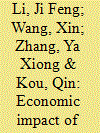

|
|
|
|
|
| Summary/Abstract |
We use a dynamic CGE model (SICGE) to assess the economic and climate impacts of emissions trading system (ETS) in China with a carbon price of 100 Yuan/ton CO2. A particular focus is given to the regulated electricity price regime, which is a major concern of electricity sector’s cost-effective participation in ETS in China. We found: (1) Carbon pricing is an effective policy for China to reduce CO2 emissions. Total CO2 emissions reduction ranges from 6.8% to 11.2% in short-term. (2) Rigid electricity price entails lower CO2 emissions reduction but can be considered as a feasible starting point to introduce carbon pricing policies in short-term as long as governmental subsidies are given to electricity production. (3) In mid- and long-term, the efficient policy is to earmark carbon revenue with competitive electricity price. We propose to use carbon revenue to reduce consumption tax in the first year of the introduction of carbon price and to use the carbon revenue to reduce production tax in following years.
|
|
|
|
|
|
|
|
|
|
|
|
|
|
|
|
| 10 |
ID:
179722
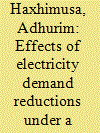

|
|
|
|
|
| Summary/Abstract |
The coronavirus pandemic (COVID-19) has led to a massive collapse in economic activity and energy demand, with the result of significant emissions reductions at a global scale. However, the existing literature investigating abatement from COVID-19 mainly overlooked the overwhelming emissions reduction in Europe's power sector. We address this by assessing the intricate relationship between electricity demand shocks and heterogeneous generation technologies in the power sectors of 16 major European economies during January to March 2020. We apply an econometric model in an instrumental-variables framework. In a first step, we assess the impact of COVID-19 infections on electricity demand, and in a second step how this translates into emissions abatement. We find that, during full lockdown, COVID-19 reduced electricity demand by 19% and carbon emissions by an astonishing 34% per hour, whereas there is severe country heterogeneity depending on the electricity supply structure and demand shock intensity. From our estimates, we predict that power sector emissions fell by 18.4% in 2020. Our results reveal the importance of a carbon price, so that a demand reduction can offset large amounts of emissions by displacing coal at the margin. We derive several policy implications from our analysis to draw lessons from the pandemic.
|
|
|
|
|
|
|
|
|
|
|
|
|
|
|
|
| 11 |
ID:
118832


|
|
|
|
|
| Publication |
2013.
|
| Summary/Abstract |
Carbon capture and storage (CCS) in China is currently discussed extensively but few in-depth analyses focusing on economics are observed. In this study, we answer two related questions about the development of CCS and power generation technologies in China: (1) what is the breakeven carbon-dioxide price to justify CCS installation investment for Integrated Gasification Combined Cycle (IGCC) and pulverized coal (PC) power plants, and, (2) what are the risks associated with investment for CCS. To answer these questions, we build a net present value model for IGCC and PC plants with capacity of 600 MW, with assumptions best representing the current technologies in China. Then, we run a sensitivity analysis of capital costs and fuel costs to reveal their impact on the carbon price, and analyze the risk on investment return caused by the carbon price volatility. Our study shows that in China, a breakeven carbon price of $61/tonne is required to justify investment on CCS for PC plants, and $72/tonne for IGCC plants. In this analysis, we also advise investors on the impact of capital and fuel costs on the carbon price and suggest optimal timing for CCS investment.
|
|
|
|
|
|
|
|
|
|
|
|
|
|
|
|
| 12 |
ID:
098929


|
|
|
| 13 |
ID:
169732


|
|
|
|
|
| Summary/Abstract |
How can governments build political support for carbon pricing? This question has challenged policy designers since the earliest programs imposing new prices on pollution, and remains a vital question today. This perspective offers insights on strategies for building greater political support for carbon pricing, based on previous experiences with long-running “auction and invest” programs in the U.S. and abroad, including the Regional Greenhouse Gas Initiative (RGGI), California's carbon pricing system, and the EU emissions trading system (ETS). Three key insights can be derived from those experiences. First: cap and trade with an auction of allowances is an important option for carbon pricing with distinctive advantages. Second, it is important to generate tangible public benefits from a carbon price that are distributed among citizens in a way that is broadly perceived as fair and addresses potential concerns about higher consumer costs for energy. Third, the most effective form of those public benefits should vary predictably across a few clearly defined categories according to local circumstances.
|
|
|
|
|
|
|
|
|
|
|
|
|
|
|
|
| 14 |
ID:
192779


|
|
|
|
|
| Summary/Abstract |
Human activities, such as burning fossil fuels for electricity generation, heating, and transport, are the primary drivers of a large amount of greenhouse gases emission. The individual consumers, able to influence the supply-chains behind the commodities their chose to fulfil their needs is the driver behind production and, consequently, its impacts. Thus, the active and willing participation of citizens in combatting climate change may be pivotal to address this issue. The present work is aimed at presenting and modelling a novel market-based carbon emission reduction mechanism, called BitCO2, designed to incentivize individual consumption choices toward lower carbon footprints. This mechanism is tested for the Italian private transportation sector thanks to an ad hoc developed System Dynamics model. The Battery Electric Vehicle (BEV) adoption, if compared with the Internal Combustion Engine Vehicle (ICEV) one, cause less CO2 emissions per km travelled. After a certain number of travelled km, a BitCO2 token is assigned to BEV owners for each ton of avoided CO2. This token can be exchanged in a dedicated market and used to get a discount on insurance services. Assuming a Social Cost of Carbon of 9.22 [2.13–22.3] €/tonCO2eq, model results show that the BitCO2 mechanism would allow for a cumulated CO2 emission reduction of 973 [68.9–5’230] ktonCO2eq over 20 years of operation with a peak of 39.3 [5.34–189] thousand additional BEV registration per year.
|
|
|
|
|
|
|
|
|
|
|
|
|
|
|
|
| 15 |
ID:
177498


|
|
|
|
|
| Summary/Abstract |
Economists generally view carbon pricing as an efficient policy to address externalities from energy use, but political feasibility can be a persistent issue. This paper aims to comprehensively consider underlying factors contributing to carbon-pricing magnitude including environmental, social, political, and economic variables. We use the between estimator and focus on exogenous variables to explain continuous carbon-pricing variables for a global sample of countries. We find that larger coal reserves per capita have a negative effect on the log of the product of carbon-price levels and coverage. Control of corruption is a key governance variable that is positively associated with carbon-pricing outcomes. Another important political dimension is the degree of political globalisation. For economic resources, there is evidence that larger stocks of domestic credit help to enable carbon pricing. There is some evidence that climate change awareness is positively associated with carbon pricing, but the proportion perceiving climate change as a serious threat is negatively associated with carbon pricing. Our global results complement case study approaches that consider carbon-pricing design for local contexts.
|
|
|
|
|
|
|
|
|
|
|
|
|
|
|
|
|
|
|
|
|